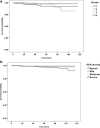Polysomnographic phenotyping of obstructive sleep apnea and its implications in mortality in Korea
- PMID: 32764677
- PMCID: PMC7411028
- DOI: 10.1038/s41598-020-70039-5
Polysomnographic phenotyping of obstructive sleep apnea and its implications in mortality in Korea
Abstract
Conventionally, apnea-hypopnea index (AHI) is used to define and categorize the severity of obstructive sleep apnea. However, routine polysomnography (PSG) includes multiple parameters for assessing the severity of obstructive sleep apnea. The goal of this study is to identify and categorize obstructive sleep apnea phenotypes using unsupervised learning methods from routine PSG data. We identified four clusters from 4,603 patients by using 29 PSG variable and arranged according to their mean AHI. Cluster 1, spontaneous arousal (mean AHI = 8.52/h); cluster 2, poor sleep and periodic limb movements (mean AHI = 12.16/h); cluster 3, hypopnea (mean AHI = 38.60/h); and cluster 4, hypoxia (mean AHI = 69.66/h). Conventional obstructive sleep apnea classification based on apnea-hypopnea index severity showed no significant difference in cardiovascular or cerebrovascular mortality (Log rank P = 0.331), while 4 clusters showed an overall significant difference (Log rank P = 0.009). The risk of cardiovascular or cerebrovascular mortality was significantly increased in cluster 2 (hazard ratio = 6.460, 95% confidence interval 1.734-24.073) and cluster 4 (hazard ratio = 4.844, 95% confidence interval 1.300-18.047) compared to cluster 1, which demonstrated the lowest mortality. After adjustment for age, sex, body mass index, and underlying medical condition, only cluster 4 showed significantly increased risk of mortality compared to cluster 1 (hazard ratio = 7.580, 95% confidence interval 2.104-34.620). Phenotyping based on numerous PSG parameters gives additional information on patients' risk evaluation. Physicians should be aware of PSG features for further understanding the pathophysiology and personalized treatment.
Conflict of interest statement
The authors declare no competing interests.
Figures


References
-
- Beaudin AE, Waltz X, Hanly PJ, Poulin MJ. Impact of obstructive sleep apnoea and intermittent hypoxia on cardiovascular and cerebrovascular regulation. Exp. Physiol. 2017;102:743–763. - PubMed
Publication types
MeSH terms
LinkOut - more resources
Full Text Sources
Other Literature Sources

